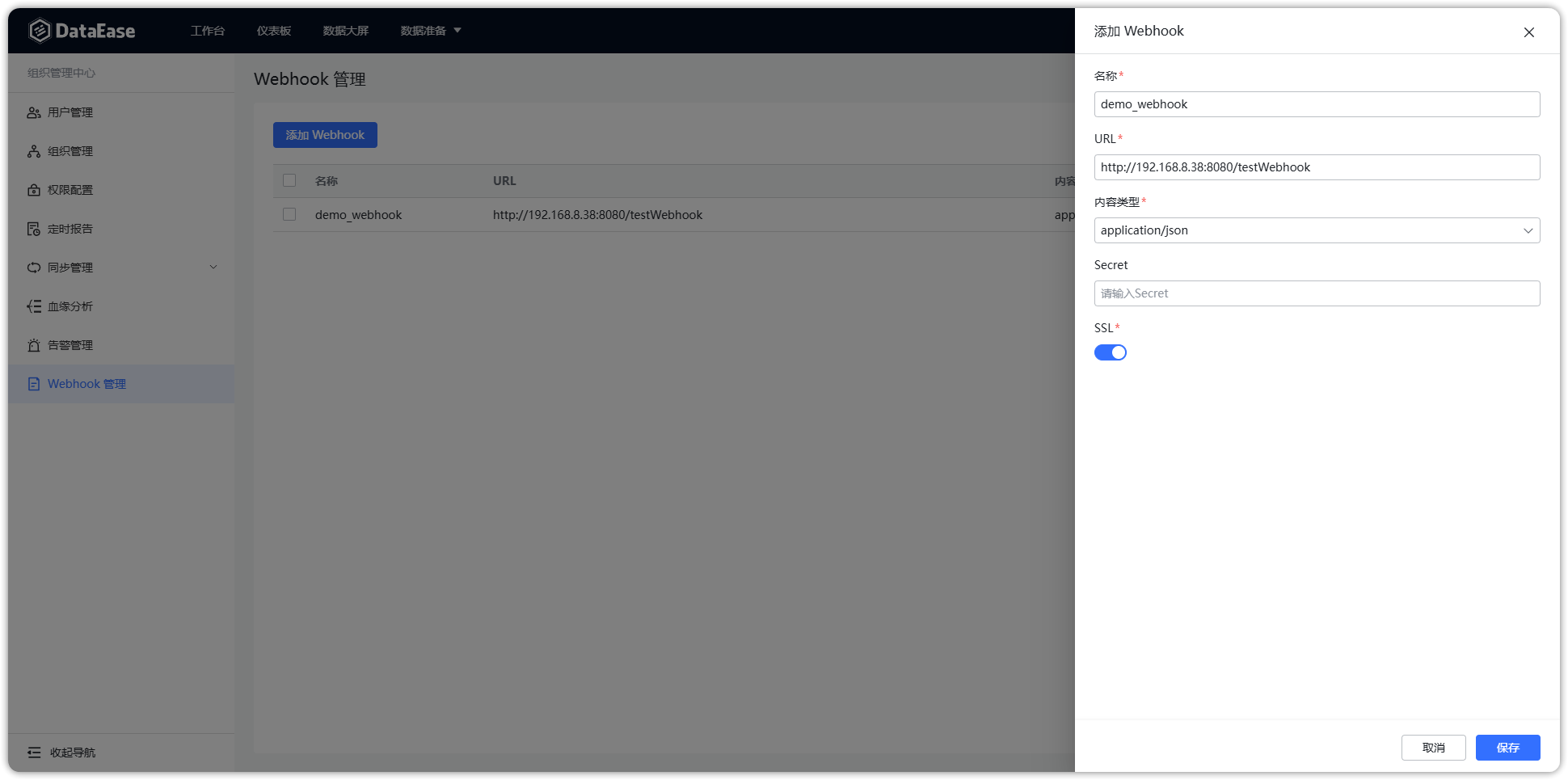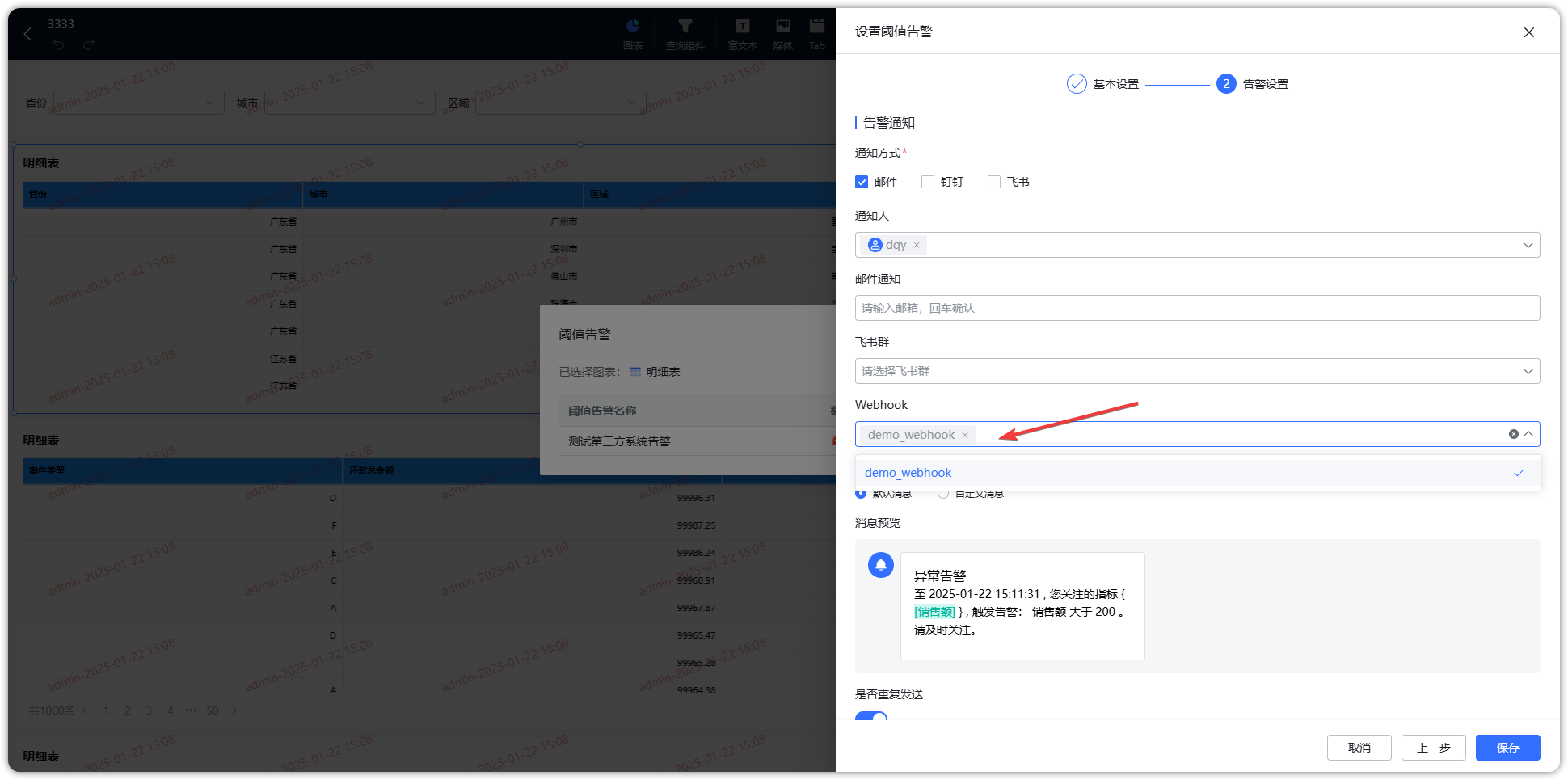1 Webhook 功能介绍
Webhook 是一种事件驱动的轻量级通信机制,通过 HTTP 在应用之间自动发送数据。Webhook 由特定事件触发,可以自动实现应用编程接口(API)之间的通信,即当某个事件发生时,系统会自动向指定的 URL 发送数据。与传统的 API 调用方式不同,API 采用的是“拉”数据的方式,即客户端主动向服务器请求数据;而 Webhook 则是“推”数据的方式,服务器在事件发生时主动向客户端推送数据,Webhook 是组织级别的内容,以便于统一管理和扩展消息推送,在 DataEase 中主要用于图表的阈值告警推送;
注:目前 DataEase 的 Webhook 功能只能对接第三方系统,无法对接企业微信、钉钉、飞书的 Webhook 机器人;
2 DataEase Webhook 的请求参数说明
请求类型 :POST
URL :第三方系统 URL
JSON 请求格式:
title :告警标题
content :告警内容
messageId :消息 ID
注:JSON 请求格式为固定格式,不能改动;
示例:
curl -X POST http://192.168.8.38:8080/testWebhook \
-H "Content-Type: application/json" \
-d '{"title":"Test Title","content":"This is a test content.","messageId":"12345"}'3 DataEase Webhook 的使用
1.DataEase 页面配置如下:

2.图表开启阈值告警功能并配置 Webhook ;

3.第三方系统需要实现接收 Webhook 对应的方法
java 代码示例:
package com.dai.demo.controller;
import com.sun.net.httpserver.HttpServer;
import com.sun.net.httpserver.HttpHandler;
import com.sun.net.httpserver.HttpExchange;
import org.json.JSONObject;
import java.io.IOException;
import java.io.OutputStream;
import java.io.BufferedReader;
import java.io.InputStreamReader;
import java.util.HashMap;
import java.util.Map;
public class TestWebhook {
public static void main(String[] args) throws IOException {
HttpServer server = HttpServer.create(new java.net.InetSocketAddress(8080), 0);
server.createContext("/testWebhook", new TestWebhookHandler());
server.setExecutor(null); // 创建一个默认的执行器
server.start();
System.out.println("服务器已启动,端口号:8080");
}
static class TestWebhookHandler implements HttpHandler {
@Override
public void handle(HttpExchange exchange) throws IOException {
try {
if ("POST".equals(exchange.getRequestMethod())) {
Map<String, String> body = readRequestBody(exchange);
String title = body.get("title");
String content = body.get("content");
String messageId = body.get("messageId");
System.out.println("标题: " + title);
System.out.println("内容: " + content);
System.out.println("消息 ID: " + messageId);
sendResponse(exchange, "OK", 200);
} else {
sendResponse(exchange, "方法不允许", 405);
}
} catch (Exception e) {
e.printStackTrace();
sendResponse(exchange, "服务器内部错误", 500);
}
}
}
private static Map<String, String> readRequestBody(HttpExchange exchange) throws IOException {
BufferedReader reader = new BufferedReader(new InputStreamReader(exchange.getRequestBody()));
StringBuilder jsonBuilder = new StringBuilder();
String line;
while ((line = reader.readLine()) != null) {
jsonBuilder.append(line);
}
String json = jsonBuilder.toString();
return JsonUtil.fromJsonString(json);
}
private static void sendResponse(HttpExchange exchange, String response, int responseCode) throws IOException {
exchange.sendResponseHeaders(responseCode, response.getBytes().length);
try (OutputStream os = exchange.getResponseBody()) {
os.write(response.getBytes());
os.flush();
}
}
}
class JsonUtil {
public static Map<String, String> fromJsonString(String json) {
JSONObject jsonObject = new JSONObject(json);
Map<String, String> map = new HashMap<>();
for (String key : jsonObject.keySet()) {
map.put(key, jsonObject.getString(key));
}
return map;
}
}pom.xml 添加对应的依赖
<dependency>
<groupId>org.json</groupId>
<artifactId>json</artifactId>
<version>20210307</version> <!-- 使用合适的版本 -->
</dependency>